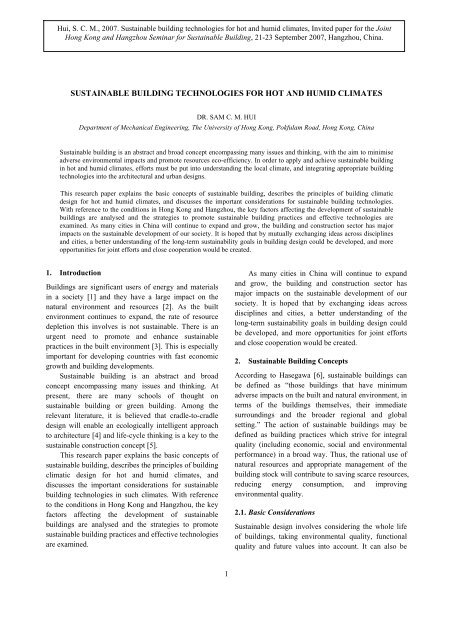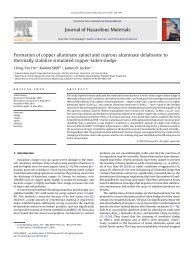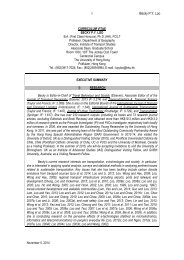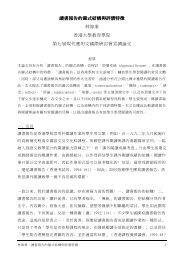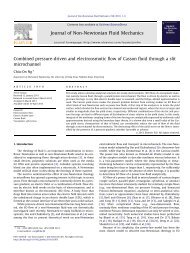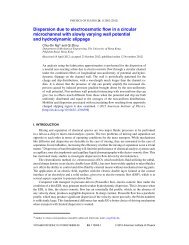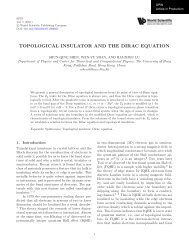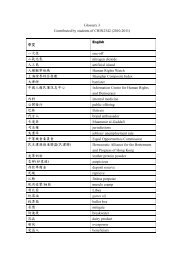sustainable building technologies for hot and humid climates
sustainable building technologies for hot and humid climates
sustainable building technologies for hot and humid climates
Create successful ePaper yourself
Turn your PDF publications into a flip-book with our unique Google optimized e-Paper software.
Hui, S. C. M., 2007. Sustainable <strong>building</strong> <strong>technologies</strong> <strong>for</strong> <strong>hot</strong> <strong>and</strong> <strong>humid</strong> <strong>climates</strong>, Invited paper <strong>for</strong> the Joint<br />
Hong Kong <strong>and</strong> Hangzhou Seminar <strong>for</strong> Sustainable Building, 21-23 September 2007, Hangzhou, China.<br />
SUSTAINABLE BUILDING TECHNOLOGIES FOR HOT AND HUMID CLIMATES<br />
DR. SAM C. M. HUI<br />
Department of Mechanical Engineering, The University of Hong Kong, Pokfulam Road, Hong Kong, China<br />
Sustainable <strong>building</strong> is an abstract <strong>and</strong> broad concept encompassing many issues <strong>and</strong> thinking, with the aim to minimise<br />
adverse environmental impacts <strong>and</strong> promote resources eco-efficiency. In order to apply <strong>and</strong> achieve <strong>sustainable</strong> <strong>building</strong><br />
in <strong>hot</strong> <strong>and</strong> <strong>humid</strong> <strong>climates</strong>, ef<strong>for</strong>ts must be put into underst<strong>and</strong>ing the local climate, <strong>and</strong> integrating appropriate <strong>building</strong><br />
<strong>technologies</strong> into the architectural <strong>and</strong> urban designs.<br />
This research paper explains the basic concepts of <strong>sustainable</strong> <strong>building</strong>, describes the principles of <strong>building</strong> climatic<br />
design <strong>for</strong> <strong>hot</strong> <strong>and</strong> <strong>humid</strong> <strong>climates</strong>, <strong>and</strong> discusses the important considerations <strong>for</strong> <strong>sustainable</strong> <strong>building</strong> <strong>technologies</strong>.<br />
With reference to the conditions in Hong Kong <strong>and</strong> Hangzhou, the key factors affecting the development of <strong>sustainable</strong><br />
<strong>building</strong>s are analysed <strong>and</strong> the strategies to promote <strong>sustainable</strong> <strong>building</strong> practices <strong>and</strong> effective <strong>technologies</strong> are<br />
examined. As many cities in China will continue to exp<strong>and</strong> <strong>and</strong> grow, the <strong>building</strong> <strong>and</strong> construction sector has major<br />
impacts on the <strong>sustainable</strong> development of our society. It is hoped that by mutually exchanging ideas across disciplines<br />
<strong>and</strong> cities, a better underst<strong>and</strong>ing of the long-term sustainability goals in <strong>building</strong> design could be developed, <strong>and</strong> more<br />
opportunities <strong>for</strong> joint ef<strong>for</strong>ts <strong>and</strong> close cooperation would be created.<br />
1. Introduction<br />
Buildings are significant users of energy <strong>and</strong> materials<br />
in a society [1] <strong>and</strong> they have a large impact on the<br />
natural environment <strong>and</strong> resources [2]. As the built<br />
environment continues to exp<strong>and</strong>, the rate of resource<br />
depletion this involves is not <strong>sustainable</strong>. There is an<br />
urgent need to promote <strong>and</strong> enhance <strong>sustainable</strong><br />
practices in the built environment [3]. This is especially<br />
important <strong>for</strong> developing countries with fast economic<br />
growth <strong>and</strong> <strong>building</strong> developments.<br />
Sustainable <strong>building</strong> is an abstract <strong>and</strong> broad<br />
concept encompassing many issues <strong>and</strong> thinking. At<br />
present, there are many schools of thought on<br />
<strong>sustainable</strong> <strong>building</strong> or green <strong>building</strong>. Among the<br />
relevant literature, it is believed that cradle-to-cradle<br />
design will enable an ecologically intelligent approach<br />
to architecture [4] <strong>and</strong> life-cycle thinking is a key to the<br />
<strong>sustainable</strong> construction concept [5].<br />
This research paper explains the basic concepts of<br />
<strong>sustainable</strong> <strong>building</strong>, describes the principles of <strong>building</strong><br />
climatic design <strong>for</strong> <strong>hot</strong> <strong>and</strong> <strong>humid</strong> <strong>climates</strong>, <strong>and</strong><br />
discusses the important considerations <strong>for</strong> <strong>sustainable</strong><br />
<strong>building</strong> <strong>technologies</strong> in such <strong>climates</strong>. With reference<br />
to the conditions in Hong Kong <strong>and</strong> Hangzhou, the key<br />
factors affecting the development of <strong>sustainable</strong><br />
<strong>building</strong>s are analysed <strong>and</strong> the strategies to promote<br />
<strong>sustainable</strong> <strong>building</strong> practices <strong>and</strong> effective <strong>technologies</strong><br />
are examined.<br />
As many cities in China will continue to exp<strong>and</strong><br />
<strong>and</strong> grow, the <strong>building</strong> <strong>and</strong> construction sector has<br />
major impacts on the <strong>sustainable</strong> development of our<br />
society. It is hoped that by exchanging ideas across<br />
disciplines <strong>and</strong> cities, a better underst<strong>and</strong>ing of the<br />
long-term sustainability goals in <strong>building</strong> design could<br />
be developed, <strong>and</strong> more opportunities <strong>for</strong> joint ef<strong>for</strong>ts<br />
<strong>and</strong> close cooperation would be created.<br />
2. Sustainable Building Concepts<br />
According to Hasegawa [6], <strong>sustainable</strong> <strong>building</strong>s can<br />
be defined as “those <strong>building</strong>s that have minimum<br />
adverse impacts on the built <strong>and</strong> natural environment, in<br />
terms of the <strong>building</strong>s themselves, their immediate<br />
surroundings <strong>and</strong> the broader regional <strong>and</strong> global<br />
setting.” The action of <strong>sustainable</strong> <strong>building</strong>s may be<br />
defined as <strong>building</strong> practices which strive <strong>for</strong> integral<br />
quality (including economic, social <strong>and</strong> environmental<br />
per<strong>for</strong>mance) in a broad way. Thus, the rational use of<br />
natural resources <strong>and</strong> appropriate management of the<br />
<strong>building</strong> stock will contribute to saving scarce resources,<br />
reducing energy consumption, <strong>and</strong> improving<br />
environmental quality.<br />
2.1. Basic Considerations<br />
Sustainable design involves considering the whole life<br />
of <strong>building</strong>s, taking environmental quality, functional<br />
quality <strong>and</strong> future values into account. It can also be<br />
1
2<br />
considered as the thoughtful integration of architecture<br />
with <strong>building</strong> services <strong>and</strong> structural engineering<br />
resources. In addition to express concern <strong>for</strong> the<br />
traditional aesthetics of massing, orientation, proportion<br />
scale, texture, shadow <strong>and</strong> light, the <strong>building</strong> design<br />
team needs to be concerned with long-term costs <strong>and</strong><br />
environmental impacts.<br />
Successful <strong>sustainable</strong> design requires an integrated<br />
approach since <strong>building</strong> systems <strong>and</strong> operational<br />
practices are dependent on sitting, solar access <strong>and</strong> light<br />
penetration, architectural design, <strong>and</strong> product<br />
specification [2]. This approach to design examines how<br />
a <strong>building</strong> interacts with its systems, activities <strong>and</strong><br />
surrounding environment.<br />
2.2. Design Objectives<br />
Hasegawa [6] has identified five major objectives <strong>for</strong><br />
<strong>sustainable</strong> <strong>building</strong>s as follows:<br />
• Resource efficiency<br />
• Energy efficiency<br />
• Pollution prevention<br />
• Harmonisation with environment<br />
• Integrated <strong>and</strong> systemic approaches<br />
To achieve these, <strong>sustainable</strong> <strong>building</strong>s must be<br />
energy <strong>and</strong> resource efficient (including greenhouse gas<br />
emissions reduction), non-wasteful <strong>and</strong> non-polluting,<br />
highly flexible <strong>and</strong> adaptable <strong>for</strong> long-term functionality.<br />
They should also be easy to operate <strong>and</strong> maintain, <strong>and</strong><br />
are supportive of the productivity <strong>and</strong> well being of the<br />
occupants (including good indoor air quality <strong>and</strong> noise<br />
abatement).<br />
To put the objectives into practice <strong>and</strong> assess the<br />
<strong>building</strong> per<strong>for</strong>mance, the following categories of<br />
criteria are often used [3].<br />
• Sustainable site<br />
• Energy efficiency <strong>and</strong> renewable energy<br />
• Water conservation<br />
• Materials <strong>and</strong> waste management<br />
• Indoor environmental quality<br />
2.3. Building Life Cycle<br />
Sustainable <strong>building</strong> emphasizes a “whole system”<br />
perspective <strong>and</strong> considers the construction process <strong>and</strong><br />
first costs, toward the life of a <strong>building</strong> <strong>and</strong> the longer<br />
term interest of the owners <strong>and</strong> occupants. Figure 1<br />
shows the concept of <strong>building</strong> life cycle <strong>and</strong> the four<br />
major aspects of <strong>sustainable</strong> construction, namely,<br />
energy, water, waste <strong>and</strong> materials [7].<br />
Figure 1. Building life cycle <strong>and</strong> <strong>sustainable</strong> construction<br />
Sustainable design takes into account the energy<br />
<strong>and</strong> environmental per<strong>for</strong>mance of the <strong>building</strong> during<br />
its complete life cycle, including site selection,<br />
construction, operations <strong>and</strong> maintenance, renovations,<br />
demolition <strong>and</strong> replacement. It requires the joint ef<strong>for</strong>ts<br />
of <strong>building</strong> designers, contractors <strong>and</strong> end-users.<br />
3. Principles of Climatic Design<br />
In the past human history, climate considerations are<br />
very important in <strong>building</strong> <strong>and</strong> urban design [8].<br />
However, with the emerging of modern architecture <strong>and</strong><br />
<strong>building</strong> services systems, the process of climatic design<br />
is often overlooked [9].<br />
The basic philosophy of climate responsive design<br />
lies upon the evaluation of climatic influence <strong>and</strong> the<br />
optimisation of <strong>building</strong> environmental per<strong>for</strong>mance<br />
[10]. In other words, we are trying to minimise the<br />
resource consumption <strong>and</strong> environmental impact<br />
through cooperation with external climate.<br />
To establish a systematic approach to this, two<br />
important areas shall be examined:<br />
• Outdoor climate<br />
• Indoor climate<br />
3.1. Outdoor Climate<br />
Sustainable design of <strong>building</strong>s <strong>and</strong> <strong>building</strong> services<br />
systems requires careful consideration of local climatic<br />
conditions <strong>and</strong> characteristics [11]. Without good<br />
in<strong>for</strong>mation <strong>and</strong> underst<strong>and</strong>ing of the local climate, it is
3<br />
not possible to ensure optimal <strong>building</strong> design <strong>and</strong><br />
efficient <strong>building</strong> services operation.<br />
To achieve energy efficiency <strong>and</strong> sustainability in<br />
<strong>building</strong>s, it is essential <strong>for</strong> Hong Kong <strong>and</strong> the cities in<br />
mainl<strong>and</strong> China to establish accurate <strong>and</strong> detailed<br />
climatic data [12]. The quality of climatic data <strong>and</strong><br />
in<strong>for</strong>mation will determine the effectiveness of <strong>building</strong><br />
design strategies <strong>and</strong> the accuracy of design load <strong>and</strong><br />
energy calculations.<br />
Table 1 shows a comparison of climatic design<br />
conditions in Hong Kong <strong>and</strong> Hangzhou. It can be seen<br />
that both cities are <strong>hot</strong> <strong>and</strong> <strong>humid</strong> in the summer, but<br />
Hangzhou is about 3.3 °C <strong>hot</strong>ter. In the winter,<br />
Hangzhou is much cooler than Hong Kong. As passive<br />
cooling by induced natural ventilation can be most<br />
effective in <strong>hot</strong> <strong>and</strong> <strong>humid</strong> <strong>climates</strong> [13], the<br />
in<strong>for</strong>mation about wind speed <strong>and</strong> prevailing wind<br />
direction will give designers some hints on optimizing<br />
the ventilation.<br />
Table 1. Climatic design conditions in Hong Kong <strong>and</strong><br />
Hangzhou (Data source: ASHRAE [14])<br />
Hong Kong Hangzhou<br />
Latitude 22.32° N 30.23° N<br />
Longitude 114.17° E 120.17° E<br />
Cooling design<br />
DB/MCWB (1%) 31.6 °C/26.5 °C 34.9 °C/26.9 °C<br />
Heating design<br />
DB (99%) 10.6 °C -1.1 °C<br />
Wind speed<br />
MCWS (summer)<br />
MCWS (winter)<br />
3.1 m/s<br />
2.2 m/s<br />
3.5 m/s<br />
1.7 m/s<br />
Wind direction<br />
PCWD (summer)<br />
PCWD (winter)<br />
270<br />
30<br />
180<br />
340<br />
Notes:<br />
1. Weather stations: Hong Kong = King’s Park, Tsimshatsui;<br />
Hangzhou = Jian Qiao.<br />
2. Abbreviations:<br />
DB = Dry bulb temperature<br />
MCWB = Mean coincident wet bulb temperature<br />
MCWS = Mean coincident wind speed<br />
PCWD = Prevailing coincident wind direction<br />
(0 = North, 90 = East)<br />
Figure 2 shows the monthly design temperatures in<br />
Hong Kong <strong>and</strong> Hangzhou. From this graph, we can<br />
study the monthly design dry bulb (DB) <strong>and</strong> mean<br />
coincident web bulb temperatures (MCWB). The<br />
monthly summaries are useful when <strong>building</strong> designers<br />
consider the seasonal variations in outdoor weather<br />
against the <strong>building</strong> use patterns <strong>and</strong> occupancy. In<br />
particular, these values can be used <strong>for</strong> determining airconditioning<br />
loads during periods of maximum solar<br />
radiation [14].<br />
Temperature (°C)<br />
40.0<br />
35.0<br />
30.0<br />
25.0<br />
20.0<br />
15.0<br />
10.0<br />
5.0<br />
0.0<br />
DB - Hong Kong<br />
MCWB - Hong Kong<br />
DB - Hangzhou<br />
MCWB - Hangzhou<br />
Jan Feb Mar Apr May Jun Jul Aug Sep Oct Nov Dec<br />
Month<br />
Figure 2. Monthly design temperatures in Hong Kong <strong>and</strong> Hangzhou<br />
(Data source: ASHRAE [14])<br />
3.2. Indoor Climate<br />
Indoor climate focuses on those physical environmental<br />
conditions created inside built environments that<br />
provide <strong>for</strong> a com<strong>for</strong>table <strong>and</strong> healthful experience, <strong>and</strong><br />
that improve human per<strong>for</strong>mance <strong>and</strong> promote work<br />
productivity. Typical indoor environmental conditions<br />
include temperature, relative <strong>humid</strong>ity, ventilation <strong>and</strong><br />
visual conditions.<br />
A <strong>sustainable</strong> ways to achieve com<strong>for</strong>t in <strong>building</strong>s<br />
is called “bioclimatic design”. It refers to the design of<br />
<strong>building</strong>s <strong>and</strong> spaces based on local climate, aimed at<br />
providing thermal <strong>and</strong> visual com<strong>for</strong>t by making use of<br />
solar energy <strong>and</strong> other environmental sources in the<br />
natural energy flows [8, 10]. Basic elements of<br />
bioclimatic design are passive solar systems which are<br />
incorporated onto <strong>building</strong>s <strong>and</strong> utlilise environmental<br />
sources (such as sun, air, wind, vegetation, water, soil,<br />
sky) <strong>for</strong> cooling, heating <strong>and</strong> lighting the <strong>building</strong> [13].<br />
Usually, at the early design stage, some simple<br />
decisions on bioclimatic design can help save energy<br />
usage later on.<br />
Figure 3 shows a com<strong>for</strong>t zone diagram which is<br />
often used to analyse the thermal conditions of indoor<br />
environment [15]. If the outdoor weather conditions of<br />
Hong Kong <strong>and</strong> Hangzhou are plotted onto this diagram,
4<br />
it can be found that in most of the time, the climatic<br />
conditions is falling outside the com<strong>for</strong>t zones.<br />
of energy use, environmental impact <strong>and</strong> indoor air<br />
quality.<br />
Bunn [17] pointed out that <strong>sustainable</strong> <strong>building</strong><br />
services in developing countries must find best-fit<br />
<strong>technologies</strong>. He argues that ostensibly energy efficient<br />
solutions will not per<strong>for</strong>m as intended unless they are<br />
appropriate <strong>for</strong> the climate, are well detailed, installed<br />
<strong>and</strong> commissioned, <strong>and</strong> are of a level of complexity that<br />
can be understood by <strong>building</strong> managers <strong>and</strong> users.<br />
Some energy saving <strong>technologies</strong> are simply switched<br />
off because they are too complex to manage.<br />
4.2. Energy Optimisation <strong>and</strong> Modelling<br />
Figure 3. ASHRAE thermal com<strong>for</strong>t zone (ASHRAE [15])<br />
Nicol [16] pointed out that the current international<br />
st<strong>and</strong>ard <strong>for</strong> indoor climate (ISO7730 based on Fanger’s<br />
predicted mean vote equations) does not adequately<br />
describe com<strong>for</strong>table conditions in <strong>hot</strong> <strong>and</strong> <strong>humid</strong><br />
<strong>climates</strong>. Thus, adaptive thermal com<strong>for</strong>t models were<br />
developed in order to address the implications of air<br />
movement <strong>and</strong> <strong>humid</strong>ity in the <strong>hot</strong>-<strong>humid</strong> tropics. Also,<br />
a variable indoor temperature st<strong>and</strong>ard will help save<br />
energy by encouraging the use of naturally ventilated<br />
<strong>building</strong>s.<br />
Energy use in a <strong>building</strong> is a function of <strong>building</strong><br />
services, the general design <strong>and</strong> the interaction of<br />
people with the <strong>building</strong> [18]. Figure 4 shows the key<br />
factors influencing energy consumption in <strong>building</strong>s.<br />
4. Sustainable Building Services<br />
Sustainable <strong>building</strong> approach enables <strong>building</strong> owners<br />
<strong>and</strong> managers to reduce energy consumption, improve<br />
the work environment, <strong>and</strong> reduce the environmental<br />
impacts of <strong>building</strong> operations. To ensure this goal,<br />
<strong>building</strong> services systems have an important role to play<br />
since the <strong>building</strong> environmental per<strong>for</strong>mance is<br />
directly affected by the <strong>building</strong> services systems.<br />
4.1. System Design Strategy<br />
It is important <strong>for</strong> the design team to re-examine basic<br />
engineering principles in order to develop appropriate<br />
system design in support of a <strong>sustainable</strong> <strong>building</strong>.<br />
Techniques such as natural ventilation, thermal-mass<br />
storage, radiant cooling <strong>and</strong> passive solar control are<br />
applications of basic thermodynamic principles. The<br />
designers must help drive innovation <strong>and</strong> be an expert<br />
in underst<strong>and</strong>ing the technical characteristics <strong>and</strong><br />
per<strong>for</strong>mance of architectural components, construction<br />
practices <strong>and</strong> maintenance/operational practices in terms<br />
Figure 4. Key factors influencing energy consumption in <strong>building</strong>s<br />
(CIBSE [18])<br />
As a significant portion of <strong>sustainable</strong> <strong>building</strong><br />
criteria are energy-related, the energy issues are usually<br />
a critical factor in determining the <strong>building</strong> per<strong>for</strong>mance.<br />
Whole-<strong>building</strong> design methods that integrate passive<br />
solar, energy efficiency, <strong>and</strong> other renewable energy<br />
<strong>technologies</strong> can be used to reduce <strong>building</strong> energy<br />
consumption. By optimising the <strong>building</strong>’s st<strong>and</strong>ard<br />
components (site, windows, walls, floors, <strong>and</strong> airconditioning<br />
systems) <strong>building</strong> owners can substantially<br />
reduce energy use without increasing construction costs.<br />
Here, computer modelling is a very useful tool in<br />
optimising design of <strong>building</strong> services systems <strong>and</strong> the
5<br />
<strong>building</strong> shell. Building energy simulation can be used<br />
to investigate in advance the ways in which costs <strong>and</strong><br />
energy consumption can be reduced [19]. It could also<br />
enable the designer to evaluate the impact of the<br />
architectural configuration on energy per<strong>for</strong>mance <strong>and</strong><br />
indoor air quality. To achieve <strong>sustainable</strong> design,<br />
designers should make use of energy analysis tools, as<br />
well as financial analysis techniques, to determine the<br />
optimal configurations of architectural <strong>and</strong> engineering<br />
components, while meeting the typical budget, schedule<br />
<strong>and</strong> aesthetic requirements.<br />
4.3. HVAC <strong>and</strong> Indoor Environmental Quality<br />
Hui [7] indicated that <strong>for</strong> <strong>hot</strong> <strong>and</strong> <strong>humid</strong> <strong>climates</strong>, the<br />
heating, ventilation <strong>and</strong> air conditioning (HVAC)<br />
system is often the most important area to consider <strong>for</strong><br />
green <strong>building</strong>s. Although HVAC systems offer many<br />
opportunities <strong>for</strong> recovery <strong>and</strong> re-use of thermal energy,<br />
the preferred solution is to use less energy in the first<br />
place. This is achievable by more energy efficient<br />
<strong>building</strong>s, systems <strong>and</strong> equipment <strong>and</strong> through<br />
improved operating <strong>and</strong> maintenance procedures.<br />
Moreover, attention should be paid to the thermal<br />
characteristics of <strong>building</strong> <strong>and</strong> strategies <strong>for</strong> minimising<br />
internal loads, examining in detail the opportunities <strong>for</strong><br />
natural ventilation <strong>and</strong> daylighting, <strong>and</strong> exploring ways<br />
to reduce the energy requirements of HVAC.<br />
In addition to improving energy efficiency <strong>and</strong><br />
environmentally sound operations, high per<strong>for</strong>mance<br />
<strong>sustainable</strong> design also seeks to provide an indoor<br />
environment that enhances the productivity of the<br />
occupants. Current research in<strong>for</strong>mation suggests that<br />
good indoor environmental quality increases alertness<br />
<strong>and</strong> improves per<strong>for</strong>mance, while reducing illnesses <strong>and</strong><br />
absenteeism [3]. Sustainable design can thus provide<br />
significant life-cycle cost savings <strong>and</strong> productivity gains<br />
in addition to energy <strong>and</strong> resource savings.<br />
5. Hong Kong Situation<br />
Hong Kong’s environmental problems are similar to<br />
most developed communities [20]. Rapid population<br />
growth, plus a high degree of commercial activities,<br />
creates pollution <strong>and</strong> environmental degradation.<br />
5.1. High Building Density<br />
With a limited supply of habitable l<strong>and</strong> <strong>and</strong> extremely<br />
dense urban conditions, the <strong>building</strong> development in<br />
Hong Kong often faces significant spatial constraints.<br />
Economic <strong>and</strong> social imperatives dictate that the city<br />
must become highly concentrated, making it necessary<br />
to increase the density to accommodate the people,<br />
reduce the cost of public services, <strong>and</strong> achieve social<br />
cohensiveness. High-rise, high-density <strong>building</strong>s<br />
represent the major urban settings in Hong Kong <strong>and</strong><br />
<strong>for</strong>m an important background <strong>for</strong> sustainability<br />
challenges.<br />
Designing <strong>sustainable</strong> <strong>building</strong>s in a complex <strong>and</strong><br />
dense urban environment like Hong Kong requires<br />
special care to the planning of urban structure,<br />
coordination of energy systems, integration of<br />
architectural elements, <strong>and</strong> utilisation of spaces [1].<br />
Simply making individual <strong>building</strong> green is too narrow<br />
a concept. It is important to consider other factors such<br />
as urban planning <strong>and</strong> transport strategy, <strong>and</strong> how they<br />
will interact <strong>and</strong> influence the results.<br />
5.2. Important Factors<br />
Sustainable <strong>building</strong> in Hong Kong must consider a<br />
range of factors which frame the current <strong>building</strong><br />
development <strong>and</strong> city lifestyle. For example, because of<br />
the important element of l<strong>and</strong> value, property<br />
developers usually dem<strong>and</strong> a fast-track development<br />
<strong>and</strong> are more concerned with selling or letting their<br />
properties quickly than on long-term benefits. Short<br />
investment horizons <strong>and</strong> rapid economic changes in<br />
society also lead to concerns about initial costs <strong>and</strong><br />
indifference to running costs <strong>and</strong> life-cycle penalties.<br />
At present, the Hong Kong government is<br />
developing some practical means to integrate<br />
<strong>sustainable</strong> development considerations into decisionmaking<br />
[20]. In doing so, some competitive advantage<br />
might be gained <strong>for</strong> creating more ecologically sound<br />
development projects.<br />
6. Conclusions<br />
A <strong>sustainable</strong> <strong>building</strong> should mean a quality <strong>building</strong><br />
that is efficient, elegant <strong>and</strong> easy to maintain,<br />
considering the efficient use of resources throughout the<br />
<strong>building</strong> life cycle <strong>and</strong> ensuring high productivity <strong>and</strong><br />
well-being of the occupants. The use of technology is<br />
an important step toward more <strong>sustainable</strong> <strong>building</strong>. In<br />
order to apply <strong>and</strong> achieve <strong>sustainable</strong> <strong>building</strong> in <strong>hot</strong><br />
<strong>and</strong> <strong>humid</strong> <strong>climates</strong>, ef<strong>for</strong>ts must be put into<br />
underst<strong>and</strong>ing the local climate, <strong>and</strong> integrating
6<br />
appropriate <strong>building</strong> <strong>technologies</strong> into the architectural<br />
<strong>and</strong> urban designs.<br />
Although the momentum <strong>for</strong> <strong>sustainable</strong> <strong>building</strong> is<br />
growing in Hong Kong, more ef<strong>for</strong>ts <strong>and</strong> creative ideas<br />
are needed to remove the barriers <strong>and</strong> provide effective<br />
solutions to meet the local requirements in an intelligent<br />
way.<br />
References<br />
1. Hui, S. C. M., 2001. Low energy <strong>building</strong> design in<br />
high density urban cities, Renewable Energy, 24 (3-<br />
4): 627-640.<br />
2. PTI, 1996. Sustainable Building Technical Manual:<br />
Green Building Design, Construction <strong>and</strong><br />
Operations, Public Technology, Inc. (PTI),<br />
Washington, D.C.<br />
3. Langston, G. A. <strong>and</strong> Ding, G. K. C. (eds.), 2001.<br />
Sustainable Practices in the Built Environment,<br />
Butterworth-Heinemann, Ox<strong>for</strong>d.<br />
4. McDonough, W. <strong>and</strong> Braungart, M., 2003.<br />
Towards a <strong>sustainable</strong> architecture <strong>for</strong> the 21st<br />
century: the promise of cradle-to-cradle design,<br />
Industry <strong>and</strong> Environment, 26 (2-3): 13-16.<br />
5. Kohler, N. <strong>and</strong> Moffatt, S., 2003. Life-cycle<br />
analysis of the built environment, Industry <strong>and</strong><br />
Environment, 26 (2-3): 17-21.<br />
6. Hasegawa, T., 2003. Environmentally Sustainable<br />
Buildings: Challenges <strong>and</strong> Policies, OECD, Paris.<br />
7. Hui, S. C. M., 2001. HVAC design <strong>and</strong> operation<br />
<strong>for</strong> green <strong>building</strong>s, In Proc. of the Shaanxi-Hong<br />
Kong Refrigeration <strong>and</strong> HVAC Seminar 2001, 11-<br />
13 June 2001, Xian, China, pp. A44-51.<br />
8. Givoni, B., 1998. Climate Considerations in<br />
Building <strong>and</strong> Urban Design, Van Nostr<strong>and</strong><br />
Reinhold, New York.<br />
9. 林 其 標 ,1997。《 亞 熱 帶 建 築 : 氣 候 , 環 境 , 建<br />
築 》, 廣 東 科 技 出 版 社 , 廣 州 。 (Sub-tropical<br />
Architecture: Climate, Environment <strong>and</strong> Building)<br />
10. Hyde, R., 2000. Climate Responsive Design: A<br />
Study of Buildings in Moderate <strong>and</strong> Hot Humid<br />
Climates, E & FN Spon, London.<br />
11. Hui, S. C. M. <strong>and</strong> Tsang, M. F., 2005. Climatic data<br />
<strong>for</strong> <strong>sustainable</strong> <strong>building</strong> design in Hong Kong, In<br />
Proc. of the Joint Symposium 2005: New<br />
Challenges in Building Services, 15 November<br />
2005, Hong Kong SAR, pp. 89-99.<br />
12. Hui, S. C. M. <strong>and</strong> Cheung, K. P., 1997. Climatic<br />
data <strong>for</strong> <strong>building</strong> energy design in Hong Kong <strong>and</strong><br />
Mainl<strong>and</strong> China, In Proc. of the CIBSE National<br />
Conference 1997, 5-7 October 1997, London<br />
13. 林 憲 德 ,1996。《 熱 濕 氣 候 的 綠 色 建 築 計 畫 : 由<br />
生 態 建 築 到 地 球 環 保 》, 詹 氏 書 局 , 台 北 。<br />
(Planning <strong>for</strong> Green Architecture in Hot <strong>and</strong> Humid<br />
Climate: From Ecological Architecture to Global<br />
Environment Protection)<br />
14. ASHRAE, 2005. ASHRAE H<strong>and</strong>book 2005<br />
Fundamentals, Chp. 28: Climatic Design<br />
In<strong>for</strong>mation, American Society of Heating,<br />
Refrigerating <strong>and</strong> Air-Conditioning Engineers,<br />
Atlanta, Georgia.<br />
15. ASHRAE, 2004. ANSI/ASHRAE St<strong>and</strong>ard 55-2004<br />
Thermal Environmental Conditions <strong>for</strong> Human<br />
Occupancy, American Society of Heating,<br />
Refrigerating <strong>and</strong> Air-Conditioning Engineers,<br />
Atlanta, Georgia.<br />
16. Nicol, F., 2004. Adaptive thermal com<strong>for</strong>t<br />
st<strong>and</strong>ards in the <strong>hot</strong>-<strong>humid</strong> tropics, Energy <strong>and</strong><br />
Buildings, 36 (7): 628-637.<br />
17. Bunn, R., 2003. Sustainable <strong>building</strong> services in<br />
developing countries: the challenge to find “bestfit”<br />
<strong>technologies</strong>, Industry <strong>and</strong> Environment, 26 (2-<br />
3): 46-51.<br />
18. CIBSE, 2004. Energy Efficiency in Buildings:<br />
CIBSE Guide F, 2nd edition, Chartered Institution<br />
of Building Services Engineers, London.<br />
19. Hui, S. C. M., 1998. Simulation based design tools<br />
<strong>for</strong> energy efficient <strong>building</strong>s in Hong Kong, Hong<br />
Kong Papers in Design <strong>and</strong> Development, Vol. 1,<br />
1998, pp. 40-46, Department of Architecture,<br />
University of Hong Kong. (available at<br />
http://web.hku.hk/~cmhui/hkpdd/hkpdd-v1.htm)<br />
20. Hui, S. C. M., 2001. The opinion of Hui,<br />
Sustainable Building, Issue 04, 2001, p. 43.


